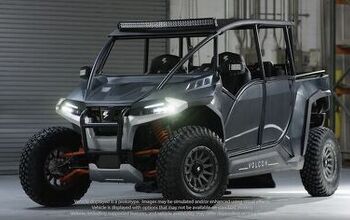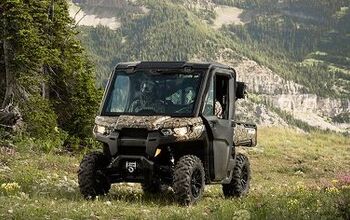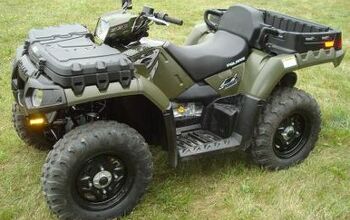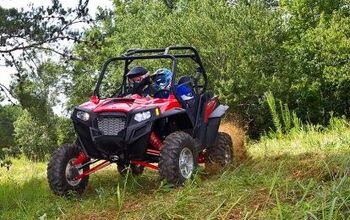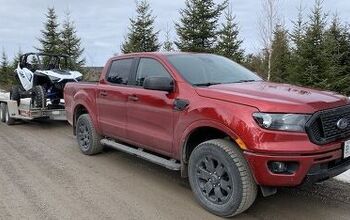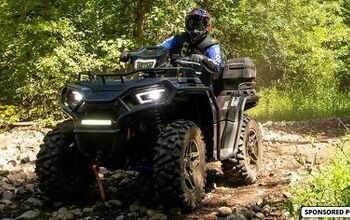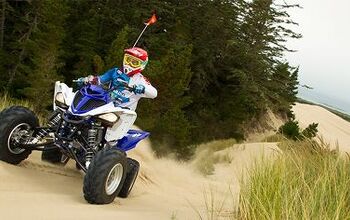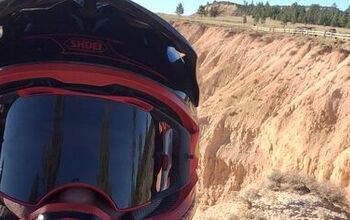Off-Road Riding and Tactical Training: Part II
Earlier this week we introduced you to our three-part series on our adventure with Yamaha at the Gunsite Academy near Prescott, Arizona ( you can read about that here). We had an eventful day one on the shooting ranges, but there was a whole lot more in store for us on days two and three. For me, day two included getting the chance to get behind the wheel of Yamaha’s all-new 2014 Viking 700 SE Tactical Black UTV, and the time spent traversing Gunsite’s 200-acre range gave me a chance to once again reflect on the core values that Yamaha and Gunsite espouse.
Triads and Pentagonals
Regardless of whether you take one of Gunsite’s pistol courses or rifles courses, Gunsite’s curriculum is distilled into three core values, called the combat triad, which were created by Gunsite founder, Lt. Col. Jeff Cooper. Picturing the three sides of a triangle, Gunsite’s core values include gun handling, marksmanship and mindset. Serious shooters will drill and drill and drill on these core values in an attempt to master them, increasing their chances of survival in a combat situation.
Day 2 at Gunsite Academy offered up more advanced firearms instruction and some off-road riding.
Similarly, Yamaha espouses core values in its ATV and UTV products, and the company designs and tests its products in an attempt to hone each of those values to a fine point in all of its products. According to Yamaha spokesmen, there are five – call it Yamaha’s performance pentagon. They include function, durability/reliability, convenience, comfort and off-road capability. Yamaha’s ATV/SxS Marketing Manager Steve Nessl was happy to provide a few examples of how this philosophy relates to the Viking 700 SE Tactical Black.
Read our Day 1 Report from Gunsite Academy
“Function can include how well the vehicle performs with and without a load, and you could tie that to off-road capability as well,” says Nessl. “Convenience would include how easy it is to drive. Comfort would definitely include the cabin. Our design is intended to be very comfortable for each individual passenger. As for durability/reliability we hang our hat on having the most durable transmission in the market, and that is documented.
“We really stand on those five pillars. When it comes to the Viking, those are the buckets where we want to check the top-most box and make sure that we are delivering those exact characteristics to our customers because that is what they look for. They want to use these vehicles as tools. They want them to be comfortable and convenient. You don’t want to not look forward to getting into your vehicle. If you look at it as something that helps you get the job done, and we are covering those main points well, then I think we have won.”
Viking 700 SE Tactical Black
In our opinion, Yamaha already has a real winner in the new Viking 700 platform. You can read our reviews of both the Electric Power Steering version and non-EPS version here, but let’s revisit a few key items.
First, from a functional standpoint, the Viking 700’s powertrain performs extremely well for both the work and play environments. Its 686cc, fuel-injected, SOHC, four-valve single-cylinder engine offers plenty of torque, and the engine’s power pulses are delivered seamlessly to the drive wheels via Yamaha’s Ultramatic dual range (high/low) transmission. The key to this smooth performance, says Yamaha, is in its full oil-batch centrifugal clutch arrangement, which maintains constant belt tension regardless of rpm or load and significantly increases belt life. This differs from sheave-style snowmobile CVTs in which the belt is constantly stretching and moving as rpm and load vary.
We’ve spent quite a bit of time in the Yamaha Viking since its introduction, but this was the first chance we’ve had to enjoy the Tactical Black special edition.
The Viking’s drive train also incorporates the ultra-convenient On-Command 4WD system that allows the driver to select two-wheel drive, four-wheel drive or fully locked differential four-wheel drive while on the go by rotating a knob located to the left of the steering wheel.
Durability and reliability were definite design targets when it came to the Viking’s 84.1-inch wheelbase steel chassis, which boasts 11.8 inches of ground clearance and 8.1 inches of suspension travel. The chassis is designed for rugged use, with flat, welded steel skid plates for underbody protection and upswept frame edges to reduce the chance of snagging the Viking on rocks, stumps and the like. Yamaha claims a total weight of 1,342 pounds for the Viking, which can accommodate an additional 600 pounds of cargo capacity in its sturdy steel bed.
Read our review of the 2014 Yamaha Viking 700 EPS
Yamaha also says that the Viking is the only “true three-passenger UTV on the market.” It’s hard to qualify the value of that statement in light of the four-passenger vehicles that are in the marketplace, but we can definitely say that our experience in the Viking’s three-passenger cabin has been nothing but positive. The Viking can carry three hefty male adults comfortably without the uncomfortable inconvenience of having them bump shoulders during the ride. Yamaha did this by setting the middle seat’s bucket five degrees behind the outer seats to offset the middle passenger’s shoulders.
With ample room in the cockpit for three, you won’t be bumping shoulders.
More attention to detail can be found in the Viking’s spacious, textured footwell area, which features dedicated space with plenty of foot traction for all three passengers and also contains a safety-improving barrier between the driver and the middle passenger that makes it difficult for the middle passenger to inadvertently reach the foot controls in rough terrain. And both passengers can easily reach the Viking’s two-step passenger hand hold for extra stability when the going gets rough.
But the Viking’s EPS may be its single strongest feature, delivering light and predictable steering performance and feedback in any terrain condition. The system incorporates a potentiometer that monitors torque on the system through the steering system in both directions, whether from the driver or from the trail, and compensates by adjusting the amount of power steering assist. More torque on the system – whether the result of a sudden twist of the steering wheel at low speed or by the deflection of the front wheels at high speed – signals the EPS to deliver more or less assist to maintain a consistent steering feel. The EPS comes standard on the Tactical Black model and is a $1,000 option on other Viking models. Having tested both versions, I can’t imagine anyone not wanting to opt for EPS.
With an MSRP of $13,749, the Viking 700 SE Tactical Black represents the top of the line for the Viking platform. For the money, you get the Viking EPS in its Special Edition matte Tactical Black paint scheme, but the model also comes loaded with a few handy Genuine Yamaha accessories, such as Yamaha’s accessory rail mounting system in the bed, which allows easy lock-down and swapping of a host of other Yamaha accessories. The SE Tactical Black also features a set of snazzy, black cast-aluminum wheels and over fenders, mud flaps, a hard sun top, and an under seat storage area.
The Tactical Black Viking offers a nice matte black paint scheme, along with a roof, rail mounting system in the bed, cast aluminum wheels, and under seat storage area.
For our Gunsite adventure, our Tactical Black Viking sample units were also fitted with a host of other Genuine Yamaha accessories, such as bed mats, a folding windshield, a black rear window, left and right side mirrors and a cargo box as well as accessory heavy-duty bumpers and brush guards and accessory lighting. Two brand-new accessories included a handy glove box bag for added security of the glove box contents and a new center console that replaces the middle passenger seat. The console can be installed and removed in just a couple minutes.
Read about our Top 10 Hunting Accessories For Your ATV
Spending time riding around the Gunsite property on the Viking 700 SE Tactical Black only reaffirmed the positive vibes from my time spent testing the non-EPS Viking. This is one sweet UTV that is ready to rock and roll no matter what you try and throw at it. As far as I am concerned, Yamaha has squarely hit the bullseye on each and every one of its performance goals for this new vehicle.
Fired Up
After our morning stroll of the grounds with the Viking 700 SE Tactical Black, our group spent more time on the rifle range, where Gunsite coach John Hutchison demonstrated the six basic rifle stances used in a combat situation. These included standing, of course, but we also learned the proper way to execute kneeling, squatting and varied seated positions, as well as how to recover from those positions. Use of these positions depends on the threat and also available cover, and it is best to learn them all.
We learned the six basic rifle stances on Day 2.
However, doing so requires that the marksman be in good shape, one area where I soon found out I could certainly use some work, as the SR762 isn’t the lightest tactical rifle in the field. As we were allowed to use which ever ones we wanted during our relays, I soon found the kneeling position to be the one in which I was able to shoot most accurately. One of the key techniques to any of the seated positions is to place the resting elbow patch ahead of the knee. Resting the elbow directly on top of the knee results in greater instability than if the shooter’s weight is rested on the tricep just behind the elbow. The difference in aim accuracy is amazing.
More than confident with the rifle by the end of our exercises, I was welcoming the opportunity to get back to the pistol range, where Chris Weare was waiting to teach us some more advanced mental techniques, such as the understanding of sight pictures when presenting the pistol for combat. Basically, there are three. The first sight picture is establishing the threat – you see the combatant and recognize the need to engage. The second involves the five-step process we had learned on day one when, including the actual firing of the pistol. The third sight picture is a sweeping view to determine if the threat has been eliminated or if more threats exist.
Now, you would think that this mental process would be an easy one to master quickly. It isn’t, and the one that gets botched the most is sight picture number three. Bear in mind that we were shooting inanimate stationary targets, so it was easy to forget that once the shot was taken, the threat area still needs to be assessed before holstering the pistol. If I had a nickel for every time I was yelled at for simply re-holstering my pistol after taking a shot, I could have bought half our group a cup of coffee. From Starbucks.
Next, we learned a two-shot, one-sight-picture technique for dealing with an established threat. It is similar to the above drill except that the shooter places the two shots in rapid fire succession in a technique that some may be more familiar with as “double tapping,” although the range instructors never used that term. I did a little better with that one.
The second part of our day’s pistol training proved a bit troublesom, the tactical reload. The tactical reload is done to ensure that the shooter always has the full amount of ammunition available as needed. As Gary Smith explained it, a tactical reload should always be done simply when you have time to do it.
The tactical reload caused some headaches.
The process is simple enough, but the order and technique are critical: The shooter retrieves a full magazine, taking care to place the index finger on the bullet of the first round. The magazine hand is then rotated while the pistol hand depresses the magazine release button and the spent magazine is captured in the web of the magazine hand. The full magazine is them firmly locked into the pistol and the spent magazine is placed in a pocket or somewhere that the shooter isn’t likely to retrieve it again quickly and thus make the potentially fatal mistake of running out of ammunition in a critical situation.
I had more than a little difficulty with this, as my pistol began to develop weird issues that made it nearly impossible to release one magazine and then fully seat the next one. Frustration set in, and it became hard to concentrate on the drill. Eventually, we realized that there was some sort of issue with the pistol, and the Ruger guys were quick to reissue me another one. However, as our time on the range ran out quickly, I never did get the chance to master this technique. Worse yet for my group, time constraints also forced the cancellation or our ride and shoot, in which we would be putting our Garmin Tactix watches to good use while seeking out hidden targets on another range. Bummer. Maybe tomorrow.
The close of day two at Gunsite left me with the impression that, while I’m a pretty decent shot, I need a lot of work in order to become a more proficient shooter. I have no doubt that practicing Gunsite’s techniques will definitely get me there. Despite my frustrations on the pistol range, I looked forward to day three, which would include my two favorite exercises and a good amount of time spent aboard the 700 Grizzly SE Tactical Black.
Stay tuned for Part III of our three-part series next week.
More by Scott Rousseau




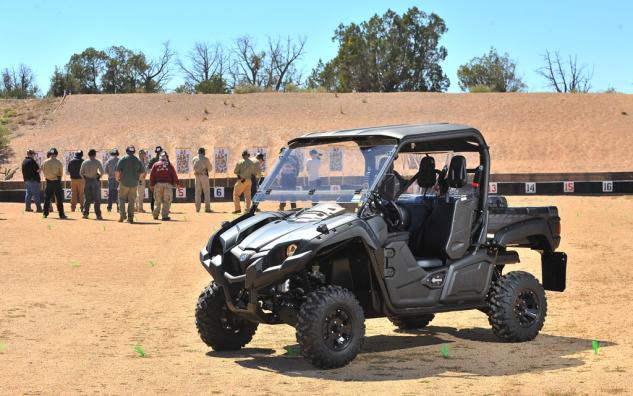













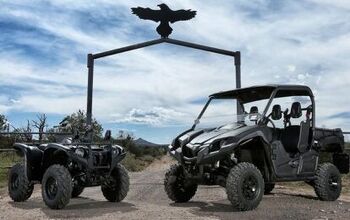
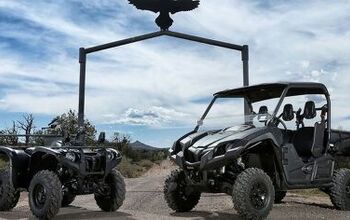
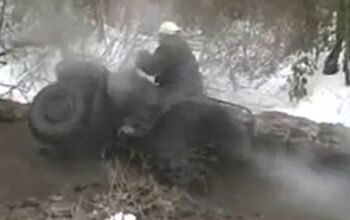
![Don't Try This at Home: Muddy Crash [video]](https://cdn-fastly.atv.com/media/2022/10/24/8744120/don-t-try-this-at-home-muddy-crash-video.jpg?size=350x220)
![Derek Guetter Lands 75-foot Back Flip [video]](https://cdn-fastly.atv.com/media/2022/10/24/8742829/derek-guetter-lands-75-foot-back-flip-video.jpg?size=350x220)
